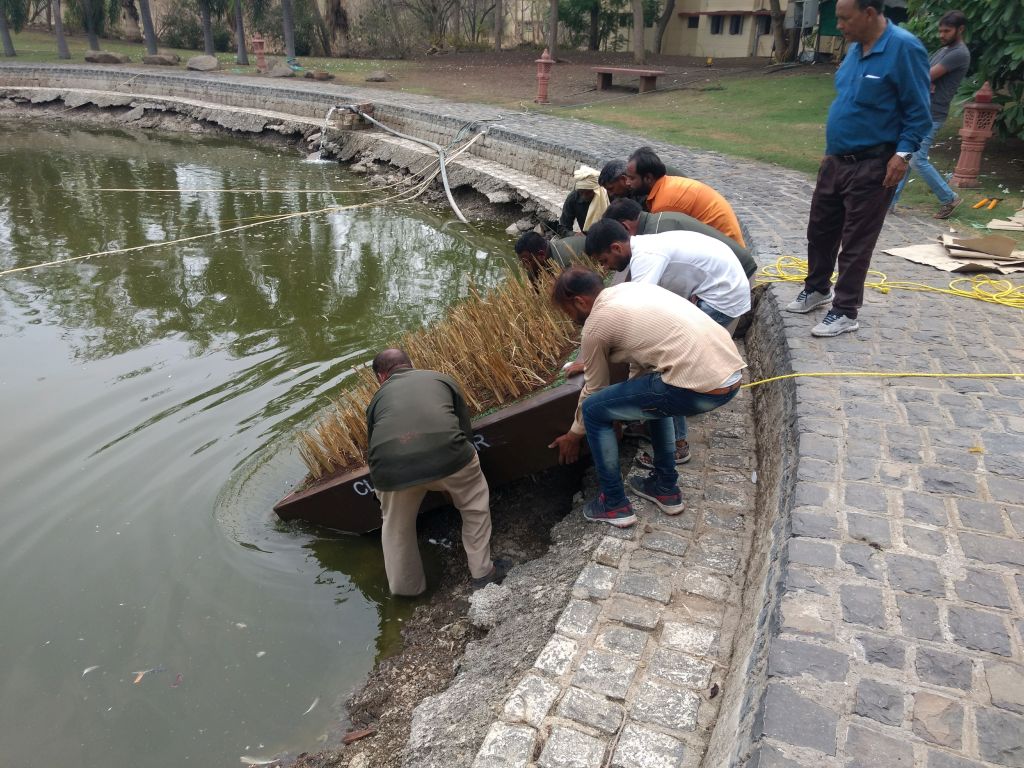Choked by sewage and effluent discharge, lakes in and around Indore are in a terrible state and in need of restoration. A bustling city in central India, Indore was declared the cleanest city in India three years in a row. After cleaning the streets and its garbage landfill area, it has now turned its attention towards cleaning as well as restoring its lakes and ponds.
The Police Training College at Musakhedi, Indore is leading the way with a spectacular pond restoration project. The campus of the Police Training College is already an oasis inside the city. With 60 different species of over 1 lakh trees spread over 100 acres, 50 types of birds species, multiple water recharge dams and wells, tree houses, butterfly gardens, a nursery, solar installations and dense forests, the Police Training College campus is a torch-bearer for eco-development.
But over time the health of Nalanda Sarovar, a 10,000 square feet artificial pond inside the Police Training College campus has deteriorated. The water was full of algae and had turned green in colour. “The water in this rainfed pond deteriorated over time. Leaves, branches from nearby trees would fall in the pond, decay and decompose, and pollute the water. The pond liner that held the water was also in tatters. That was when I decided to do something about it and to restore this pond,” says Priyanshu Kumath, the head of Clean Water, an organisation working in the field of water treatment and water-body restoration in Indore. Clean Water has installed floating islands at multiple lakes in Indore such as the Police Training College, Musakhedi, Bicholi Mardana Lake, Harsola Lake, etc.

After surveying the pond and testing the water, it was uncovered that nutrients such as nitrogen and phosphorus were the main problem in the lake. Phosphorus and nitrogen are primary nutrients that in excessive amounts, are known to pollute lakes. The dead leaves and branches of nearby trees decaying in the pond had caused the nutrients level to rise. Floating islands, also known as floating treatment wetlands were the ideal way to remove the nutrients from the pond. Floating islands are platforms which float on water and have plants planted on them.
Floating islands mimic nature’s process and provide a wetland effect at Indore (Video: Clean Water)
The roots of these plants eventually extend into the water. Bio-films, which are colonies of friendly bacteria, come and attach to the plant roots and bio-media underneath the island. Together the plants and the bio-film remove the unwanted nutrients from the water. This green technology is environment-friendly and is very low maintenance. The island requires almost no maintenance and the plants require the same attention as growing plants on land.
One after another, Clean Water planted 12 floating islands of four varieties on the pond and planted wetland plants such as canna, vetiver grass and umbrella palm. As the plants grow, their roots extend beneath the island into the water. It was soon realized that there was a lot of sludge deposited in the bottom of the pond, which had to be removed before the onset ofthe monsoons.
The team pumped the remaining water out of the pond and began removing the sludge from the bottom of the pond. The fish in the pond were re-located to a nearby well. Once the pond was clean, the pond liner was also re-installed properly. A lining of cement blocks wascreated all around the pond to ensure that leaves no longer fell into the pond.

Clean Water realized that the water quality in this stagnant pond could be further improved if the water was constantly re-circulated and aserated. A bio-filter and aeration system was installed in the lake.
This bio-filter pumps up the water from the lake, filters it in a filter with bio-media in it and then the water cascades back into the lake in the form of a waterfall. This ensures bio-treatment of water as well as aeration and oxygenation of the pond.
With the onset of the monsoons, the system rebooted. The water quality has improved significantly. New fish which eat algae and muck at the bottom of the pond were added to the lake. Native species of fish were given preference, to introduce into the pond. A ghat (with steps) was also constructed to access the pond without harming the pond-liner.
Unwanted trees which littered the pond premises were also removed. Fruit, flower and shade bearing trees were planted all along the boundary of the pond. The pond has also been decorated with plants such as rose, marigold and canna.
Trees which grow up to 40 feet have also been planted on the east and west side of the pond to form a wall to provide the pond with two extra hours of shade daily. These trees will reduce the direct sunlight falling on the pond to prevent and reduce algal growth in the future. Birds such as titori, bagoola, peacocks and many more are now coming to the pond, which is a sign that this project is ecologically sound. Residents of the Police Training College have started visiting the pond after their duty hours in the evening.
Water warriors like the Clean Water team, eco-campuses such as the Police Training Centre and cities such as Indore are leading the way towards water body conservation and restoration. Researchers and other organizations need to monitor test results and other changes so as to prepare case studies to build credibility of technology. Only when there are multiple successful cases of water-body restoration would this technology gain mass acceptance and only then can it be scaled.
Disclaimer: The views and opinions expressed in this article are those of the author and do not necessarily reflect the policy or position of India Water Portal.













